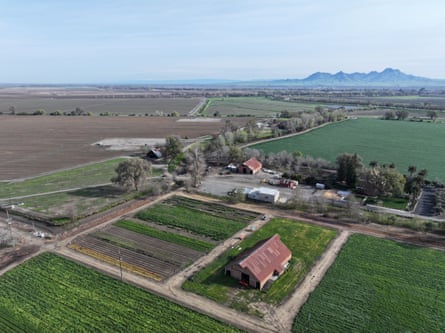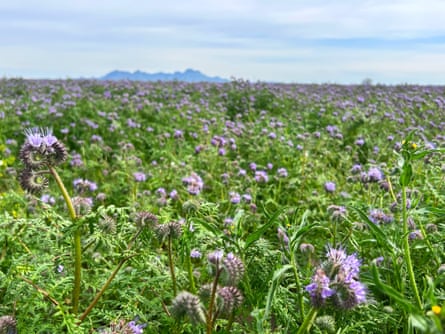Meet the seed collector restoring California’s landscapes – one tiny plant at a time
April 19, 2025
Deep in California’s agricultural heartland, Haleigh Holgate marched through the expansive wildflower-dotted plains of the San Luis national wildlife refuge complex in search of something precious.
She surveyed the native grasses and flowering plants that painted the Central valley landscape in almost blinding swaths of yellow. Her objective on that sweltering spring day was to gather materials pivotal to California’s ambitious environmental agenda – seeds.
“Over there it’s a brighter yellow, so I know those flowers are still blooming, rather than going to seed production,” she noted. “Versus over here, it’s these hues of deeper reds and deeper gold. That seed is ready.”
As a seed collection manager with the non-profit Heritage Growers native seed supplier, Holgate is tasked with traveling to the state’s wildlands to collect native seeds crucial for habitat restoration projects.
The need has become particularly acute as California aims to conserve 30% of its land by 2030, with the governor pledging to restore “degraded landscapes” and expand “nature-based solutions” to fight the climate crisis. And as the Trump administration systematically rolls back efforts to reduce greenhouse gas emissions and protect public lands, the state’s goals have taken on even greater importance.
But the rising demand for seeds far outpaces the available supply. California faces an “urgent and growing need” to coordinate efforts to increase the availability of native seeds, according to a 2023 report from the California Native Plant Society. There simply isn’t enough wildland seed available to restore the land at the rate the state has set out to, Holgate said.

Bridging the gap starts with people like Holgate, who spends five days a week, eight months of the year, traveling with colleagues to remote spots across the state collecting seeds – an endeavor that could shape California’s landscape for years.
That fact is not lost on the 26-year-old. It’s something she tries to remind her team during long, grueling hot days in the oilfields of Kern county or the San Joaquin valley.
“What we do is bigger than just the day that we live. The species that we collect are going to make impacts on the restoration industry for decades to come,” Holgate said.
Seeds play a vital role in landscape recovery. When fires move through forests, decimating native species and leaving the earth a charred sea of gray ash, or when farmlands come out of production, land managers use native seeds to help return the land to something closer to its original form. They have been an essential part of restoring the Klamath River after the largest dam removal project in US history, covering the banks of the ailing river in milkweeds that attract bees and other pollinators, andLemmon’s needlegrass, which produces seeds that feed birds and small mammals.
California has emphasized the importance of increasing native seed production to protect the state’s biodiversity, which one state report described as “the most imperiled … of any state in the contiguous United States”. Three-quarters of native vegetation in the state has been altered in the last 200 years, including more than 90% of California wetlands, much of them here in the Central valley.
For the state to implement its plans, it needs a massive quantity of native seeds – far more than can be obtained in the wild. Enter Heritage Growers, the northern California-based non-profit founded by experts with the non-profit River Partners, which works to restore river corridors in the state and create wildlife habitat.
The organization takes seed that Holgate and others collect and amplifies them at its Colusa farm, a 2,088-acre property located an hour from the state capital. (The ethical harvesting rules Heritage Growers adhere to mean that they can take no more than 20% of seeds available the day of collection.)
Workers dry the seeds collected in the wild over several weeks, clean them and send them off to a lab for testing. The farm cultivates them to grow additional seeds, in some cases slowly expanding from a small plot to a tenth of an acre, and eventually several acres. The process – from collection to amplification – can take years. Currently, the farm is producing more than 30,000lbs of seeds each year and has more than 200 native plant varieties.

The goal, general manager Pat Reynolds said, is to produce source-identified native seed and get as much of it out in the environment as possible to restore habitat at scale. The group has worked with federal agencies such as the National Parks Service, state agencies and conservation organizations, and provided seed for River Partners’ restoration efforts of the land that would become California’s newest state park, Dos Rios.
The benefit of restoring California’s wildlands extends far beyond the environment, said Austin Stevenot, a member of the Northern Sierra Mewuk Tribe and the director of tribal engagement for River Partners.
“It’s more than just work on the landscape, because you’re restoring places where people have been removed and by inviting those people back in these places we can have cultural restoration,” Stevenot said. “Our languages, our cultures, are all tied to the landscape.”
He pointed to Dos Rios, where there is a native-use garden within the park where Indigenous people can collect the plants they need for basketweaving.
“It’s giving the space back to people to freely do what we would like for the landscape and for our culture,” he said.
Just three farms in California produce thousands of pounds of native seed each year, including Heritage Growers, Reynolds said, meaning that restoration efforts take significant long-term planning. In the case of the Klamath River project, it took at least five years of work – collecting the seed, cleaning it and amplifying it at multiple farms – to obtain the seed necessary to use for river restoration.
But before Heritage Growers can amplify seed, Holgate has to gather materials in the wild. Holgate, a sunny and personable seed collector who studied environmental science and management with a focus in ecological restoration, has developed Heritage Growers’ program over the last two years.

In late March, she headed out to scout the Arena plains area of the Merced national wildlife refuge, more than 10,200 acres of protected lands, including wetlands and vernal pools, in the San Joaquin valley. Her winter break had come to an end and collection season was kicking off again, meaning months of travel and logging upward of 1,000 miles a week as she and a group of wildland seed collectors visited dozens of sites across the valley and in the foothills. Collection days typically start when the sun rises, and stretch until it gets too hot to work.
In recent weeks, Holgate’s team had planned their collection strategy and surveyed sites to see what plants were available. Getting to the Arena plains area required a 30-minute drive down a bumpy dirt road.
In a large white pickup, she passed a large owl perched in a tree and navigated a narrow creekside lane. From her vehicle, Holgate often performs what she describes as “drive-by botany”, quickly scouting the land to see what’s available.
She maneuvered through a herd of curious, but cautious, calves before trudging through thick mud and carefully slipping through barbed wire fencing to take in the scene.
Equipped with a bucket, a sun hat and a backpack, Holgate was eager to observe the landscape, noting what was seeding and what needed more time. The work is simultaneously thrilling and sometimes tedious, Holgate said as she compared two plants that looked identical but were in fact different species. Seed collectors must be able to distinguish between species to ensure the materials they collect are genetically pure, she noted.
The temperature climbed to 89F as she meandered across the plains, noting which species were available and how ripe the seeds were.
Holgate monitored a herd of cattle approaching. When she began working in the area, Holgate viewed the creatures and the way they trampled through the vernal pools and chomped on the vegetation as a significant impact to the landscape, she said. But she later learned how grazing can benefit this ecosystem. The depressions cattle make as they move through the area allow seeds to nestle further into the ground, and their grazing reduces invasive grasses, allowing flowers to receive more sunlight and giving them space to bloom, Holgate noted.
Chasing down seeds is a nomadic lifestyle in which one has to be OK with long stretches away from home, and an inordinate amount of prepared road food, like bacon and gouda sandwiches from Starbucks, Holgate said, pausing as a coyote and its pup ran through nearby flowers, winding through the cows and heading just out of sight. Along with travel to distant locations from the wildlife refuge to Kern county in the south, Holgate has to return any seeds collected to the Heritage Growers farm within 24 to 48 hours.
But the mission is worthwhile, Holgate said. The seeds she collects are expensive, but if they can be amplified and expanded, native seeds will become more abundant and restoration projects can happen more quickly.

“We can restore California faster,” she said. “It’s the only way we are going to be able to restore California at the rate we want to.”
The seed collection team has 35 sites they will return to this season. Spending so many hours on the same swaths of land has allowed Holgate and her colleagues to know the areas on a far deeper level than they would if they were just hiking through. It’s left her with a familiarity she can’t shake – that dainty grass isn’t just grass, it’s hair grass, the lighter spots are Hordeum depressum, a type of barley, and the dots of yellow are lasthenia. Sometimes the plants seep into her dreams.
“I know that when I’m dreaming about a certain species, I should go check that population and see what’s happening. And normally there’s something going on where it’s like grasshoppers came in and ate all the seed, or the seed is ripe and ready, and I gotta call in a crew,” she said.
“I’ve really put my whole heart into this job. I realize it’s more than just getting a paycheck – and it’s more than just doing this restoration for the land. It’s doing restoration for people.”
Search
RECENT PRESS RELEASES
Related Post



